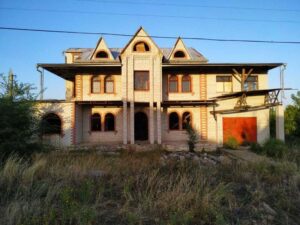Tetyana Parkhomenko, a 63-year-old pensioner from Snihurivka, Mykolaiv Region, has told the Kyiv Post of her harrowing war experience at the hands of Russian occupying forces.
“On March 12 or 13, the Russians dropped a bomb on my street near my house. There was such a powerful explosion that several buildings were destroyed and many buildings were damaged. One woman, who I knew, died. She ended up under rubble and suffocated from carbon monoxide,” Tetyana Parkhomenko explained, who now lives safely abroad.
- View the newest war in ukraine update in the Kyiv Post’s daily news stories that came out today.
- Access the newest Ukraine news items published today.
JOIN US ON TELEGRAM
Follow our coverage of the war on the @Kyivpost_official.
On March 19, a column of enemy hardware invaded Snihurivka, a town of 12,600 people, 544 km south of Kyiv. Russian forces occupied Snihurivka and began the “cleansing” of locals.
At the start of the occupation, the Russian occupiers searched the homes of Ukrainians. Snihurivka residents said the Russians looted local stores. Worse still, there was no water or electricity, so residents were forced to get water from a source near a river, from another side of which enemy artillery was firing at the town.
“The occupiers searched my house, even an old barn. They asked me whether I had weapons and information. I told them that I was an old woman and fed cats in that barn. I don’t have any weapons. So, they left,” Mrs. Parkhomenko added.
The woman hid in the basement during the entire occupation. There was a generator there, so she could charge her phone but the connection was virtually non-existent. So, she couldn’t even contact her children. Soldiers brought her water and juice from looted stores, as it was plain to see the items were made in Ukraine.
“A dingy, dirty basement, where you couldn’t sleep normally, just sitting and napping. All of this pressed me psychologically. I felt like I was in a trap everywhere: at home, in the basement, the town,” she added.
Life under occupation was very stressful. She recalls how she was close to suffering a stroke. “Russian occupiers didn’t cause me any harm, but I was even afraid of their look. When he spoke with me, his gun was always aimed at me. After the first meeting with him, I suffered mental distress and cried for a long time. My heart ached and my legs swayed.”
The woman managed to leave the town one week after the occupation began. The Russians let out residents. They checked only men’s ID and mobile phones attentively. After spending a week in a basement, the pensioner had to go on foot to a car to flee occupation. She left with a friend of her children. It was tense and dangerous. The column of cars she was in got out safely, but another evacuation column leaving Snihurivka that was ahead of them was fired upon by the Russians. Tetyana’s daughter is helping her to get to Germany. The 10-flat house, which she left to become a refugee, now has just one occupant.
Snihurivka is still under occupation to this day. The Russians plan to hold a fake referendum, as they did in the Luhansk and Donetsk Regions, on forming the so-called Kherson people’s republic. The town is being destroyed on a daily basis by artillery. Newsletters, leaflets and posters are being printed to hold fake elections in the occupied territory of Kherson Region. Locals are confident that there will be no voting. But fake voting could be held in Snihurivka on the basis of data collected while the Russians gave out “humanitarian aid”. Their aim is to use the so-called voting to unite Snihurivka to Kherson Region.
“For me, war is strife and sorrow. I was kicked out of a warm house at my old age, to go who knows where,” Tetyana Parkhomenko added sorrowfully, as she began her new life.
You can also highlight the text and press Ctrl + Enter






